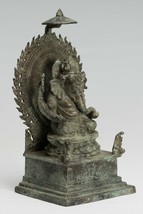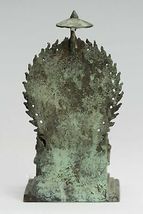Rendered at 15:53:32 04/26/25
Antique Javanese Style Bronze Seated Indonesian Ganesha Statue - 23cm/9"
Shipping options
Seller handling time is 1 business day Details
FREE to United Kingdom
Offer policy
OBO - Seller accepts offers on this item.
Details
Return policy
Full refund available within 30 days
Purchase protection
Payment options
PayPal accepted
PayPal Credit accepted
Venmo accepted
PayPal, MasterCard, Visa, Discover, and American Express accepted
Maestro accepted
Amazon Pay accepted
Nuvei accepted
Shipping options
Seller handling time is 1 business day Details
FREE to United Kingdom
Offer policy
OBO - Seller accepts offers on this item.
Details
Return policy
Full refund available within 30 days
Purchase protection
Payment options
PayPal accepted
PayPal Credit accepted
Venmo accepted
PayPal, MasterCard, Visa, Discover, and American Express accepted
Maestro accepted
Amazon Pay accepted
Nuvei accepted
Item traits
| Category: | |
|---|---|
| Quantity Available: |
Only one in stock, order soon |
| Condition: |
Unspecified by seller, may be new. |
| Region of Origin: |
Southeast Asia |
| Primary Material: |
Bronze |
| Product: |
Statue |
| Sub-Type: |
Ganesha |
| Seller Notes: |
“Good condition. No damage.” |
Listing details
| Seller policies: | |
|---|---|
| Shipping discount: |
No combined shipping offered |
| Posted for sale: |
More than a week ago |
| Item number: |
1163653958 |
Item description
Antique Javanese Style Bronze Standing Indonesian Ganesha Statue - 23cm/9"
Measures (Height) 23cm/9"
Antique Javanese style bronze seated Ganesha from Indonesia.
Ganesha is seated on a double lotus petal pedestal, which is itself resting upon a decorated square pedestal. The distinctive patina of the piece is particularly delightful. Ganesha is the elephant headed son of Shiva.
He holds an axe in one hand, tusk, fly whisk and a bowl of sweetmeats in his other hands. Whilst an elephant-headed deity wielding an axe may inspire images of a belligerent warhead, rest assured these items represent something far more encouraging. Instead, these instruments are rooted in metaphor and promote the idea that we should cut away the obstacles before us. In destroying our vices and obstacles, be they certain hurdles in our lives or more abstract feelings such as jealousy and anger, we can source new beginnings and cultivate a new approach to the things that have been worrying us.
Ganesha also holds laddus, the name for Indian sweetmeats. Whilst some may interpret this as Ganesha simply having a sweet tooth or a (relatable) penchant for candy, it is no surprise that the sweet delicacies carry further meaning. These tasty treats represent the reward for a wisely-led life and the eternal sweetness that comes from a fulfilled experience. Dentists around the world will be delighted to hear that Ganesha is never depicted actually eating the sweetmeats, but this item of the deity does also show his parallels with everyday human life. This relates to Ganesha's status as a Vedic God, which means he does not forget even those who are not his devotees and instead looks out for everyone. This is communicated through his depiction as always looking upwards or at eye-level, as he is surveying all human life and is therefore not solely focussed on those praying to him.
Here Ganesha also holds the remnants of his broken tusk. The breaking of the tusk has several backstories. One instance suggests that it was shattered when Shiva cut the head off the elephant, prior to bestowing it onto Ganesha. Another writes that Ganesha's quill broke and he needed a writing instrument, try telling your boss that next time you try to write up a report with an elephant tusk because your computer crashed. Regardless of its multiple origins, the holding of the tusk represents less of a keepsake, and more of a depiction that our spirituality is more important than our outer bodies, meaning we must overcome the duality of the two as separate entities.
The direction of Ganesha's trunk has symbolic meaning. Here the trunk turns to Ganesha's left. This signifies the direction for success in the world. It is a position associated with grihastas, or householders.
A beaded aureole with flaming rim and parasol over his head sit behind him. These symbolize his divinity. In his early forms in India, Ganesha was associated with fertility. Later he became widely revered as the Remover of Obstacles and more generally as Lord of Beginnings and Lord of Obstacles, patron of arts and sciences and the deity of intellect and wisdom.
One of the most recognizable of the Asian deities this representation of Ganesha is sure to enlighten your home with endlessly timeless style.
SATISFACTION GUARANTEE - We have been offering SE Asian Art for many years and are proud of the reputation we have developed for fair and honest listings. However, if for any reason, whatsoever, you are unhappy with your purchase please just let us know and we will provide a full refund. We want you to be 100% happy with your purchase. We have other antique Asian statues available. Please check out our other listing where we have other beautiful Asian pieces available.
Added to your wish list!

- Antique Javanese Style Bronze Seated Indonesian Ganesha Statue - 23cm/9"
- 1 in stock
- Price negotiable
- Handling time 1 day.
- Returns/refunds accepted
Get an item reminder
We'll email you a link to your item now and follow up with a single reminder (if you'd like one). That's it! No spam, no hassle.
Already have an account?
Log in and add this item to your wish list.


























